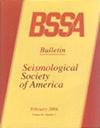日本中部关东地区板块界面上的机械耦合区,产生大地震和慢滑事件
IF 2.9
3区 地球科学
Q2 GEOCHEMISTRY & GEOPHYSICS
引用次数: 1
摘要
我们通过分析全球卫星导航系统的数据,在日本中部关东地区的板块界面上发现了机械耦合区或高应力率斑块。估计的斑块与过去每~ 5年发生一次的大地震和慢滑事件(Mw ~ 6.5)的震源区域很好地对应。利用其中一个估计的斑块,我们创建了一个慢滑事件的模型,作为5年复发间隔的应力释放。这种合成可以再现观察到的慢滑事件的特征,如滑动分布和震级。我们用最小应变能释放定义的应变能量级Mw0来量化该量级。在应变能量释放方面,这对于比较慢滑事件与普通地震是有用的,而在这种情况下,矩级并不能表示能量释放的差异。慢滑事件的应变能量级为Mw0 4.9,明显小于矩量级,这是由于慢滑事件的应力降越小,应变能释放越小。此外,假设自上次地震发生以来,应力在过去地震震源区对应的其他斑块上积累,我们得到了2023年的应力积累模型。然后,我们创建了各种大地震的破裂场景,作为不同斑块破裂的组合。当两个或三个板块同时释放累积应力时,关东地区可发生7.8级的板间地震。本文章由计算机程序翻译,如有差异,请以英文原文为准。
Mechanically Coupled Areas on the Plate Interface in the Kanto Region, Central Japan, Generating Great Earthquakes and Slow-Slip Events
We detected the mechanically coupled areas, or high stress rate patches, on the plate interface in the Kanto region, central Japan, by analyzing the Global Navigation Satellite Systems data. The estimated patches correspond well with the focal areas of past great earthquakes and slow-slip events (Mw∼6.5) occurring every ∼5 yr. Using one of the estimated patches, we created a model of a slow-slip event as a stress release with a recurrence interval of 5 yr. This synthetic can reproduce observed features of the slow-slip events such as the slip distribution and the magnitude. We use the strain-energy magnitude Mw0 defined by the minimum strain-energy release to quantify the magnitude. This is useful to compare slow-slip events with ordinary earthquakes in terms of the strain energy release, whereas the moment magnitude does not represent the difference of the energy release in this case. The strain-energy magnitude of the slow-slip event was Mw0 4.9, which was considerably smaller than the moment magnitude, because the smaller stress drop of the slow-slip event results in a smaller strain-energy release. Furthermore, by assuming that stress has accumulated at the other patches corresponding to the source region of past earthquakes since the occurrence of the last earthquakes, we obtain a model of the stress accumulation in 2023. We then create various rupture scenarios of great earthquakes as combinations of ruptures of the different patches. When two or three of the patches release the accumulated stress simultaneously, an interplate earthquake with Mw≥7.8 can occur in the Kanto region.
求助全文
通过发布文献求助,成功后即可免费获取论文全文。
去求助
来源期刊

Bulletin of the Seismological Society of America
地学-地球化学与地球物理
CiteScore
5.80
自引率
13.30%
发文量
140
审稿时长
3 months
期刊介绍:
The Bulletin of the Seismological Society of America, commonly referred to as BSSA, (ISSN 0037-1106) is the premier journal of advanced research in earthquake seismology and related disciplines. It first appeared in 1911 and became a bimonthly in 1963. Each issue is composed of scientific papers on the various aspects of seismology, including investigation of specific earthquakes, theoretical and observational studies of seismic waves, inverse methods for determining the structure of the Earth or the dynamics of the earthquake source, seismometry, earthquake hazard and risk estimation, seismotectonics, and earthquake engineering. Special issues focus on important earthquakes or rapidly changing topics in seismology. BSSA is published by the Seismological Society of America.
 求助内容:
求助内容: 应助结果提醒方式:
应助结果提醒方式:


